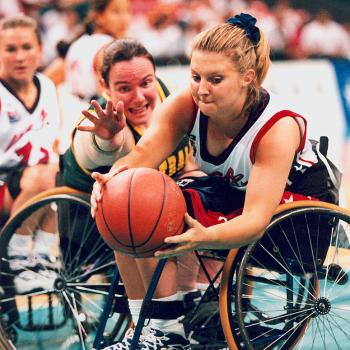For those who’ve followed the news from afar, The Catholic Miscellany has some great stories posted about the flooding in South Carolina:
Here’s the story of a family rescued from their home as the waters hit chest-high on the ground floor:
The first two boats wouldn’t start. Anxiety built, but eventually the neighbors were able to crank a pontoon boat and steered it toward the Duprees’ front door.
Emory, 8, was trying to keep her 6-year-old brother, Watson, calm as her mom and dad explained that a boat was going to come and they would carry the children outside. Emory’s words ended up inspiring the entire family.
“She said ‘You know, Watson, God challenges us but He knows we can handle it, and it’s going to be OK,’” Mr. Dupree said. “That was surprising to us. It was a very special moment.”
The family attends St. Joseph’s, which is near some of the worst of the Midlands flooding. Follow the link for notes on how to help with their relief efforts. The parish itself was untouched, as it sits on high ground. Here’s a round-up of the damage to Catholic parishes, schools, and nursing homes, and other facilities around the state.
I mentioned in a previous post that our diocesan Catholic Charities (directly overseen by the bishop) is a good destination for your almsgiving if you wish to help with flood relief. You can read about some of their work here, as well as other local Catholic relief efforts in the immediate aftermath. If a particular group or parish grabs your attention as one you’d like to support directly, you can find contact info by trolling around the diocesan website at SCCatholic.org.
You’ll notice that on the front of that page right now is a tiny square with an appeal from the bishop for donations to assist in flood relief. Let’s talk about that.
“Flood Victim.” I don’t think that word means what you think it means.
When we think of people who need assistance post-flood, the obvious category is families like the Duprees, whose homes were filled with water. That’s one category, and a serious one. Another group talked about less are those whose business or farm was shut down due to the flooding. The third group, and it’s the one that the various Catholic social assistance programs are especially well-equipped to help, are the families being pushed just over the edge with small-scale flood-related expenses.
Here’s SCDOT’s road closure update for today, from their Facebook page:
South Carolina Department of Transportation (SCDOT) Acting Secretary Christy A. Hall has issued her Sunday, Oct. 25, update on the transportation system in South Carolina.
Secretary Hall’s report has information including:
• State road closures are down from a peak of 541 (Oct. 5) to 129 (Oct. 25), a 76 percent decrease.
• More than 425 SCDOT highway workers, approximately 67 crews, are staffing the recovery effort.
• 15 debris collection trucks and trailers are operating. More than 36,000 cubic yards of debris collected total.
• SCDOT Call Center is operating 6 am—7 pm daily. There have been over 3.5 million visits to the SCDOT Road Conditions webpage during this event.
• All Interstate highways are open.
• 12 primary routes remain closed statewide.
• The majority of the current closures are on the state’s Secondary System.A complete copy of the Secretary’s Oct. 25 update can be found at this link:http://www.scdot-transfer.org/…/SecretaryStormRecoveryRepor…
Secretary Hall’s report summarized several topics including the resources deployed by SCDOT in the state’s recovery effort, the current condition of the state-maintained highway system including remaining closures, a review of other modes of transportation such as rail, aviation, marine and transit services and debris removal operations.
It’s good news overall. SCDOT mobilized crews from around the state, and they’ve been working like crazy people to re-open roads. Keep in mind that we’re talking about major structural damage on a massive scale — stuff that DOT usually just doesn’t see. For DOT, this flood was like waking up one morning and being told that you have to build 500 new roads. Today.
For the families affected by these road closures, it’s like waking up and discovering that for the next month, or two, or three, your commute has just doubled or tripled.
That’s a minor inconvenience if you’ve got a good cushion of savings and a solid social network in place. But if you were already trying to figure out from month to month how to pay your car expenses, or already just barely getting out of work in time to pick up your kids from school or the babysitter’s house, now something really big has to give. Rent? Utilities? Hospital bills?
These are the people the bishop’s stewardship appeal are particularly well-suited to help. Catholic, diocesan-funded programs around the state are already providing prescription assistance, help with utility bills, food, clothing, and a pile of other small but important fill-the-gap, in-kind helps for families that get underwater every now and then. They are already the pro’s at helping people stay in their homes, hold onto to their jobs, and generally push through the current crisis and get onto steady footing.
These groups are already working in tandem with other agencies to coordinate services and help clients find the kind of help that they need, in the amount that will genuinely benefit them. These groups are already established in the areas affected by the floods. It doesn’t matter whether you can’t pay your water bill because you are trying to rebuild your entire life or because you just can’t afford to live thirty miles farther from work than you did last week. Either way, you need help keeping the water on, and the diocesan collection is ideal for providing that kind of help.
Here’s the entry page for the diocese, and here’s a direct link to the donations page. Use the comments section on the donation form to indicate that your donation is specifically for flood relief. Thanks!

Artwork: Adi Holzer: The Flood, 1975. Used by permission, via Wikimedia.












